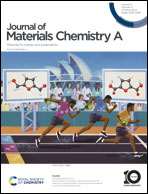Boosting photocatalytic performance of CdxZn1–xS for H2 production by Mo2C MXene with large interlayer distance†
Abstract
Here we report a novel heterostructure with ultrahigh photocatalytic performance for H2 production. The heterostructure consists of CdxZn1−xS solid solution and two dimensional Mo2C MXene. The Mo2C MXene works as a co-catalyst, which was made from Mo2Ga2C by etching in cetyltrimethylammonium bromide (CTAB) solution at 160 °C for 24 h. Different from the MXene made by the general method of fluoric acid etching, the Mo2C MXene made by this method had ultra large interlayer space (lattice parameter c = 24.5 Å) due to the in situ intercalation of CTA+. Thereafter, the Mo2C MXene without a delamination process was used as the substrate to grow Cd0.8Zn0.2S (CZS) at room temperature, followed by heating in a hydrothermal process to achieve the phase conversion of CZS from sphalerite to wurtzite. The CZS/Mo2C photocatalyst (mass ratio of Mo2C : CZS = 0.2 : 1) achieves an ultrahigh photocatalytic H2 production activity of 44.19 mmol g−1 h−1, surpassing pure CZS by a satisfying factor of ≈2289%. It is higher than that of other MXene-co-catalysts and other noble-metal-free CSZ-based photocatalysts reported to date.

- This article is part of the themed collection: #MyFirstJMCA


 Please wait while we load your content...
Please wait while we load your content...